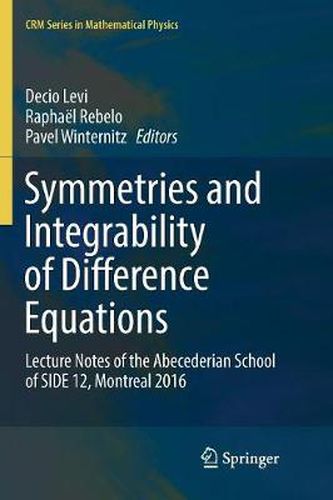Readings Newsletter
Become a Readings Member to make your shopping experience even easier.
Sign in or sign up for free!
You’re not far away from qualifying for FREE standard shipping within Australia
You’ve qualified for FREE standard shipping within Australia
The cart is loading…






This title is printed to order. This book may have been self-published. If so, we cannot guarantee the quality of the content. In the main most books will have gone through the editing process however some may not. We therefore suggest that you be aware of this before ordering this book. If in doubt check either the author or publisher’s details as we are unable to accept any returns unless they are faulty. Please contact us if you have any questions.
This book shows how Lie group and integrability techniques, originally developed for differential equations, have been adapted to the case of difference equations. Difference equations are playing an increasingly important role in the natural sciences. Indeed, many phenomena are inherently discrete and thus naturally described by difference equations.
More fundamentally, in subatomic physics, space-time may actually be discrete. Differential equations would then just be approximations of more basic discrete ones. Moreover, when using differential equations to analyze continuous processes, it is often necessary to resort to numerical methods. This always involves a discretization of the differential equations involved, thus replacing them by difference ones.
Each of the nine peer-reviewed chapters in this volume serves as a self-contained treatment of a topic, containing introductory material as well as the latest research results and exercises. Each chapter is presented by one or more early career researchers in the specific field of their expertise and, in turn, written for early career researchers. As a survey of the current state of the art, this book will serve as a valuable reference and is particularly well suited as an introduction to the field of symmetries and integrability of difference equations. Therefore, the book will be welcomed by advanced undergraduate and graduate students as well as by more advanced researchers.
$9.00 standard shipping within Australia
FREE standard shipping within Australia for orders over $100.00
Express & International shipping calculated at checkout
This title is printed to order. This book may have been self-published. If so, we cannot guarantee the quality of the content. In the main most books will have gone through the editing process however some may not. We therefore suggest that you be aware of this before ordering this book. If in doubt check either the author or publisher’s details as we are unable to accept any returns unless they are faulty. Please contact us if you have any questions.
This book shows how Lie group and integrability techniques, originally developed for differential equations, have been adapted to the case of difference equations. Difference equations are playing an increasingly important role in the natural sciences. Indeed, many phenomena are inherently discrete and thus naturally described by difference equations.
More fundamentally, in subatomic physics, space-time may actually be discrete. Differential equations would then just be approximations of more basic discrete ones. Moreover, when using differential equations to analyze continuous processes, it is often necessary to resort to numerical methods. This always involves a discretization of the differential equations involved, thus replacing them by difference ones.
Each of the nine peer-reviewed chapters in this volume serves as a self-contained treatment of a topic, containing introductory material as well as the latest research results and exercises. Each chapter is presented by one or more early career researchers in the specific field of their expertise and, in turn, written for early career researchers. As a survey of the current state of the art, this book will serve as a valuable reference and is particularly well suited as an introduction to the field of symmetries and integrability of difference equations. Therefore, the book will be welcomed by advanced undergraduate and graduate students as well as by more advanced researchers.